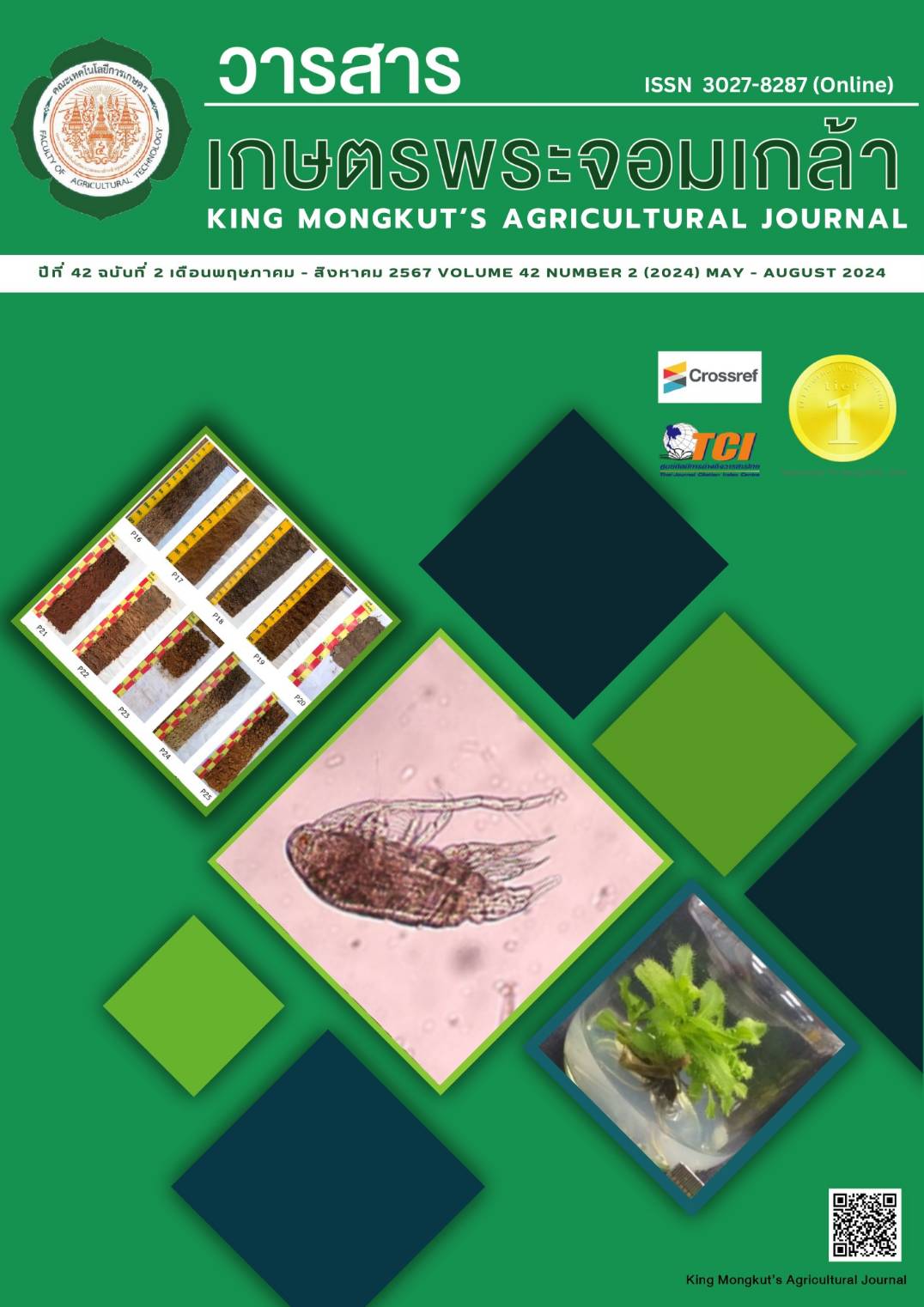Effect of Parboiling Times and Temperatures Drying of Riceberry on Antioxidant Activity
Main Article Content
Abstract
The aim of this research was to investigate the effect of parboiling riceberry at 100°C for 10, 20 and 30 minutes and drying at 50, 60 and 70°C on antioxidant activity. The moisture content of parboiled rice was approximately of 15 - 16% db. The experimental results showed that color L*, a* and b* were in the range of 29.53 - 32.74, 0.88 - 1.00 and 0.14 - 0.18, respectively. The total phenolic content, %DPPH scavenging activity and ferric reducing antioxidant power (FRAP) of riceberry after process were decreased in the range of 10.00 - 10.90 mgGAE/g, 69.52 - 81.80% and 7.14 - 7.99 mgFeSO4/g, respectively, when compared to reference rice. Parboiling for 10 min and drying at 50°C were the most suitable in this study.
Article Details

This work is licensed under a Creative Commons Attribution-NonCommercial-NoDerivatives 4.0 International License.
King Mongkut's Agricultural Journal
References
American Association Cereal Chemistry. (1995). Approved Methods of the American Association Cereal Chemistry. 9th ed. St.Paul.
Ayamdoo, A. J., Demuyakor, D., Dogbe, W., Owusu, R., & Ofosu, M. A. (2013). Effect of varying parboiling conditions on physical qualities of jasmine 85 and nerica 14 rice varieties. American Journal of Food Technology, 8, 31-42.
Benzie, I. F., & Strain, J. J. (1999). Ferric reducing/antioxidant power assay: Direct measure of total antioxidant activity of biological fluids and modified version for simultaneous measurement of total antioxidant power and ascorbic acid concentration. Methods in Enzymology, 299, 15-27.
Bhattacharya, K. R. (1985). Parboiling of rice. In: Juliano, B. O., ed. Rice: Chemistry and Technology. St. Paul.
Boonmawat, S., Ratphitagsanti, W., & Haruthaitanasan, V. (2019). Effect of superheated steam heating on quality and antioxidant activities of riceberry bran. Agriculture and Natural Resources, 53, 130-138.
Champagne, E. T. (2004). Rice: Chemistry and Technology. 3rd ed. The American Association of Cereal Chemists Inc.
Chen, M. H., & Bergman, C. J. (2005). A rapid procedure for analyzing rice bran tocopherol, tocotrienol and c-oryzanol contents. Journal of Food Composition and Analysis, 18, 319-331.
Dao, V. T. T. (2015). Optimization of drum drying process parameters for pumpkin powder production and its substitution in rice noodles. Journal of Science, 3, 149-160.
Deng, G. F., Lin, X., Xu, X., Gao, L., Xie, J., & Lia, H. (2013). Antioxidant capacities and total phenolic contents of 56 vegetables. Journal of Functional Foods, 5, 260-266.
Elbert, G., Tolaba, M. P., & Suárez, C. (2001). Effects of drying conditions on head rice yield and browning index of parboiled rice. Journal of Food Engineering, 47(1), 37-41.
Hou, Z., Qin, P., Zhang, Y., Cui, S., & Ren, G. (2013). Identification of anthocyanins isolated from black rice (Oryza sativa L.) and their degradation kinetics. Food Research International, 50(2), 691-697.
Hu, Z., Tang, X., Liu, J., Zhu, Z., & Shao, Y. (2017). Effect of parboiling on phytochemical content, antioxidant activity and physicochemical properties of germinated red rice. Food Chemistry, 214, 285-292.
Jongjitt, K., Donthuan, J., Prathumtet, J., Kaewkhamjan, P., & Kansuk, P. (2017). Determination of antioxidant, total phenolic compounds and facial cream formulation from Antidesma bunius extract. Isan Journal of Pharmaceutical Sciences, 13(Suppl.), 209-218.
Kongkachuichai, R., Prangthip, P., Surasiang, R., Posuwan, J., Charoensiri, R., Kettawan, A., & Vanavichit, A. (2013). Effect of riceberry oil (deep purple oil; Oryza sativaindica) supplementation on hyperglycemia and change in lipid profile in streptozotocin (STZ)-induced diabetic rats fed a high fat diet. International Food Research Journal, 20, 873-882.
Leardkamolkarn, V., Thongthep, W., Suttiarporn, P., Kongkachuichai, R., Wongpornchai, S., & Wanavijitr, A. (2011). Chemopreventive properties of the bran extracted from a newly developed Thai rice: The riceberry. Food Chemistry, 125(3), 978-985.
Liu, Q., Kong, Q., Li, X., Lin, J., Chen, H., Bao, Q., & Yuan, Y. (2020). Effect of mild-parboiling treatment on the structure, colour, pasting properties and rheology properties of germinated brown rice. LWT, 130, 109623.
Luang-In, V., Yotchaisarn, M., Somboonwatthanakul, I., & Deeseenthum, S. (2018). Bioactivities of organic riceberry broken rice and crude riceberry rice oil. Thai Journal of Pharmaceutical Sciences, 42(3), 161-168.
Sirisoontaralak, P., Nakornpanom, N. N., Koakietdumrongkul, K., & Panumaswiwath, C. (2015). Development of quick cooking germinated brown rice with convenient preparation and containing health benefits. LWT, 61(1), 138-144.
Shao, Y., Xu, F., Sun, X., Bao, J., & Beta, T. (2014). Identification and quantification of phenolic acids and anthocyanins as antioxidants in bran, embryo and endosperm of white, red and black rice kernels (Oryza sativa L.). Journal of Cereal Science, 59, 211–218.
Skerget, M., Kotnik, P., Hadolin, M., Hraš, A. R., Simonič, M., & Knez, Z. (2005). Phenols, proanthocyanidins, flavones and flavonols in some plant materials and their antioxidant activities. Food Chemistry, 89, 191-198.
Wang L., Xie, B., Shi, J., Xue, S., Deng, Q., Wei, Y., & Tian, B. (2010). Physicochemical properties and structure of starches from Chinese rice cultivars. Food Hydrocolloids, 24, 208-216.
Wiriyawattana, P., Suwonsichon, S., & Suwonsichon, T. (2018). Effects of drum drying on physical and antioxidant properties of riceberry flour. Agriculture and Natural Resources, 52, 445-450.


